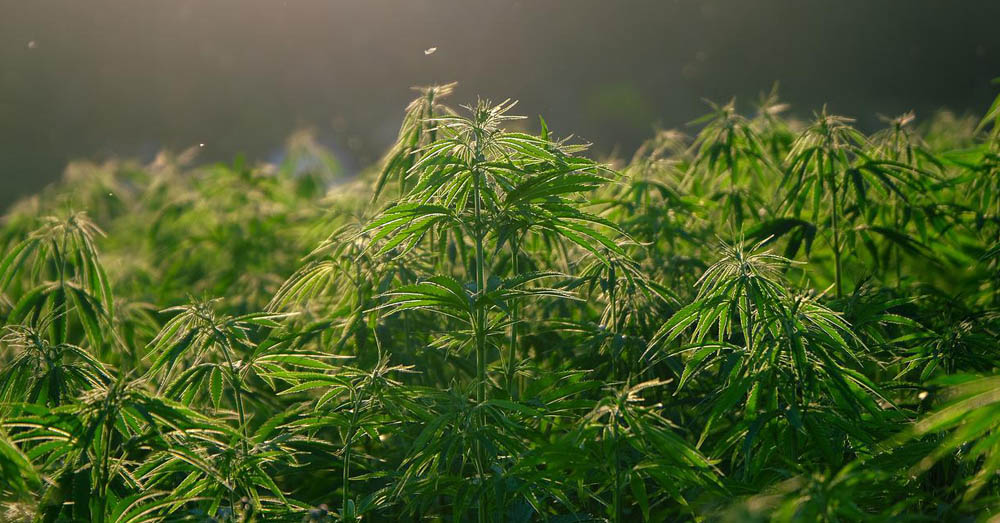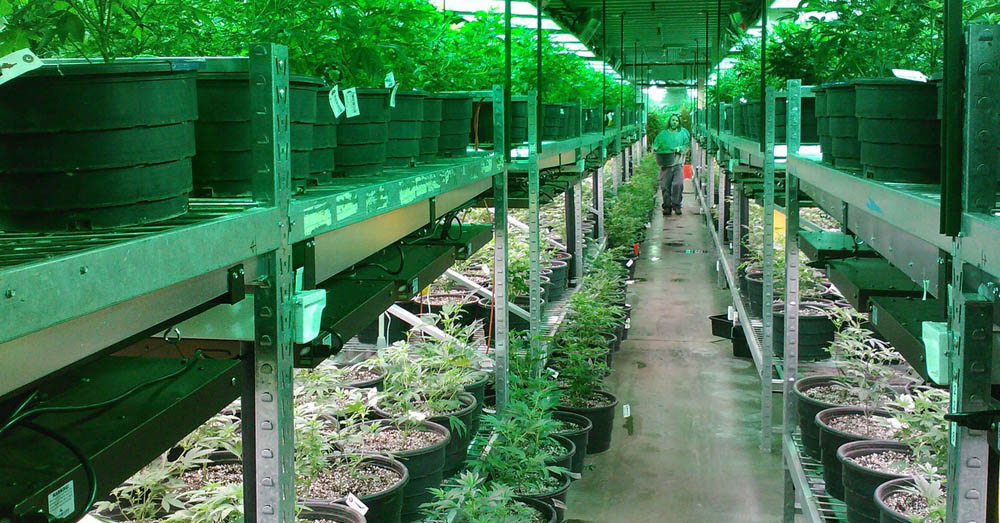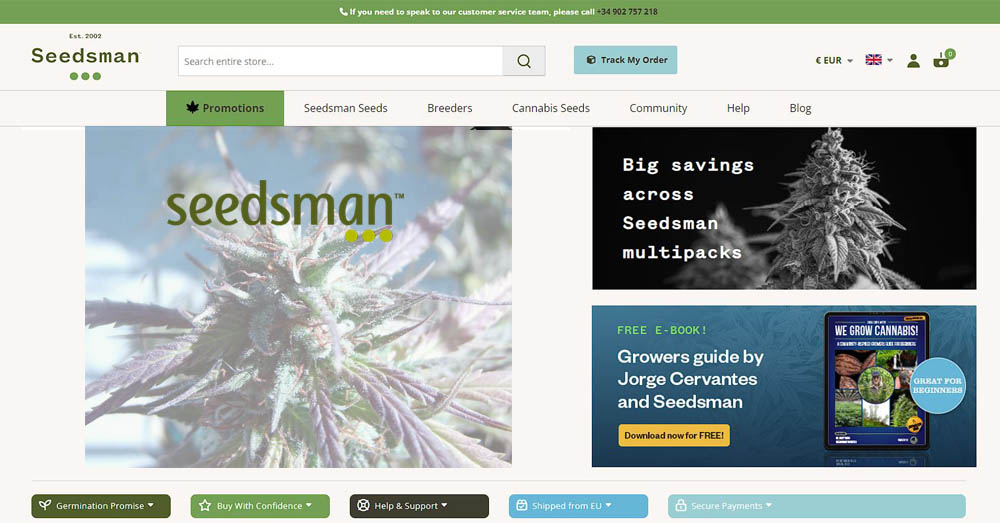Are the leaves of your marijuana plants dry or curling up? Are you noticing nutrient burn happening?
Your plants may be suffering from low humidity. Fortunately, raising grow tent humidity isn’t a challenge you can’t overcome.
Increasing humidity in grow tent setups can involve simple household items you can easily find or some grow tent additions you might need.
Let’s discuss how to raise the humidity in grow tent setups and what indoor growers should know about humidity levels.
What Is Humidity?

To help you understand better, let’s discuss what humidity is first.
Humidity is how much water vapor is present in the air. This can depend on the air temperature, as warm air can hold more water vapor than cold air.
The higher the temperature is, the higher the humidity can be.
Maintaining the humidity inside your grow tent at the right level is important, especially because you’re growing cannabis plants in an enclosed area.
There are three ways to measure humidity.
It can either be measured by relative humidity, absolute humidity, or specific humidity. Indoor growers like you only have to concern themselves with relative humidity so let’s focus on this.
The relative humidity is what impacts cannabis plants the most. It is the moisture content of the air relative to or in comparison to how much the air can hold at a specific temperature. High relative humidity feels thick because more water vapor is saturating the air.
Take, for example, a 70% humidity level at 60 degrees.
It’s not holding as much moisture as a 70% humidity level at 80 degrees because, as we’ve mentioned, a higher temperature can hold more moisture.
How Does Humidity Affect Plant Growth?
Grow plants absorb moisture either through their leaves or through their roots. Their stomata, the so-called pores on their leaves, determine which ones they will use.
Just like pores, they regulate the internal temperatures of cannabis plants. In hot air, they close to prevent moisture loss. This makes plants pull moisture through their roots instead.
Measuring humidity in grow tents is important because the right humidity level allows plants to absorb water through their leaves.
Low humidity forces cannabis plants to drag more water through their roots, which may result in nutrient burn.
The correct humidity levels play an important role in the proper growth of cannabis plants.A young plant can thrive in a humid environment. Lack of humidity puts more pressure on their tender roots. This can lead to dehydration and the closing of stomata.
14 Ways on How to Raise Humidity in Grow Tent
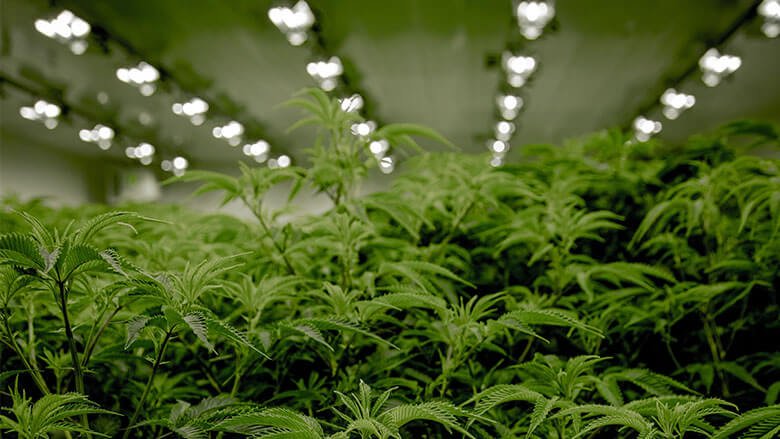
If you want a good grow tent for your cannabis, you can check out the best grow tents for cannabis!
If you’re noticing symptoms of lack of humidity in your plants, these are the ways how you can add humidity to your grow tent setup.
1) Mist Your Plants
The simplest way to quickly boost the humidity in grow tent is to mist plants using a spray bottle.
This is best for taking care of seedlings, cuttings, and younger plants because, as we’ve mentioned, these plants take in water through their leaves.
The best way to do this is to spray on both the top and underside of your leaves.
If you want to know the best time to do this, we say in the morning. This gives enough time for water to evaporate without much risk of disease and pests setting in.
2) Mix Mature And Young Plants
If your growing plants consist mostly of young ones, you can add mature plants into the mix to release more moisture in the air and increase humidity.
You might wonder, “won’t the bigger plants rob the younger plants of light, nutrients, and air?” The answer is no.
You shouldn’t worry about this because younger plants take moisture from the air while larger plants take water through their roots.
Large plants respire more. The larger the plant, the more water it may need but the more moisture it will release.
Aside from moisture, carbon dioxide is also released. You can use these to increase your grow tent humidity and feed your smaller plants.
The only thing you must remember here is not to overcrowd the larger plants. Ensure your younger plants get their fair share of light, nutrients, and airflow.
3) Hang Wet Towels
Dealing with limited space, you may be unable to add larger plants to your grow tent to raise humidity levels. That’s alright. Hanging a wet towel will do the trick for raising humidity in grow rooms.
Hanging wet towels is a life hack many indoor growers have been using. The water from the wet towels evaporates to raise the humidity in your grow tents.
To do this, you only have to soak your wet towels and hang them. You can hang them along the metal framing in the interior of your grow tent.
Position them, so the water droplets don’t fall onto your marijuana plants.
A wet towel can dry up fast, so check every two hours to wet it again.
4) Leave Wet Sponges on the Floor
Another way to increase humidity in small grow tents is by using wet sponges.
If you’re looking for a way to increase humidity in grow tent fast without constantly checking on your sponges drying out, this one’s for you.
Increasing the water surface in your grow tent will increase humidity. It’s best to put your wet sponges near air intake tubing and other passive air holes.
Or, if you want, you can place them beside every grow tray to increase humidity levels near your plants.
Ensure that you use clean water and check your sponges once every couple of weeks to avoid fungi or bacteria growth in your grow tent.
5) Place an Open Container of Water in the Grow Tent
Following the same principle of more water surface means more humidity. You can put any open container of water in your grow tent. This time, however, you can raise humidity gradually and consistently.
Choose a container that is appropriate for the size of your grow tent. Common containers you can use are bowls, buckets, trays, and several of them.
You’ll be able to raise humidity as water evaporates from the containers. In terms of placement, placing your water near your air flow, such as on a shelf in your grow room, is best.
6) Lower the Temperature of Your Tent Surroundings
Aside from adding materials to increase humidity, you can also adjust certain variables relating to your grow tent environment. One of which is the temperature of its surroundings.
Here’s why. Humidity comes hand in hand with temperature. Warmer air can hold more water vapor.
A lower temperature around your grow tent can immediately increase humidity. It moistens up the air while allowing colder air to sink at the bottom of your grow tent. This facilitates the warm, moist air to rise toward the top of your grow tent.
7) Cool Down Your Tent
If you can’t do much about the surrounding temperature of your grow tent, adjust the temperature within your grow tent to attain high humidity.
You can add an air conditioner or water chiller inside your grow tent. If you have a heater instead of an air conditioner, lower its temperature.
You’ll need a temperature drop to build humidity. If your existing air conditioner can’t cool down your grow tent any further, you might have to try the other options of raising humidity instead.
8) Lower the Speed of Your Extraction Fan
Another variable you can look into is the speed of your extraction fan. Reducing its speed facilitates more humidity to stay in your grow tent temporarily.
Do this only for a short while. You need your extraction fan for fresh air and good airflow. However, air flow also lowers humidity. Look into the best fans for your grow tent.
This close relation of airflow and humidity is the reason why you can only do this method temporarily while you find another way to increase humidity.
9) Remove Half of Your Grow Lights
Aside from ventilation, your grow tent must have grow lights, too. They are artificial lights used in indoor planting to provide the full spectrum, and light intensity plants need to grow.
Despite this, lights emit heat also. As you must already know, humidity lowers when the temperature rises. If you remove about half of your lights, this should reduce temperatures and increase humidity.
In contrast to the short-term solution offered by changing your extraction fan speed, you can do with only half of your lights for a longer time. That’s if you’re taking care of mostly baby plants. They don’t need as much light as more mature plants.
10) Change Your Floor Soil
Here’s one thing that’s found in all grow tents: soil. This may surprise you, but the soil you’re using contributes to the humidity level of your grow tent as well.
Choose one that offers more water-holding capacity to adjust your floor soil to raise the humidity. Create a pathway or flooring with this soil and a large water surface area.
As we’ve discussed, increasing your water surface increases humidity, too. After doing this, it won’t be long until you see a rise in your relative humidity levels.
To keep the plants healthy, you may consider using a carbon filter for your grow room to help sustain your plants and soil better!
11) Use a Humidifier
You may be the type of indoor grower who doesn’t want to get their hands too dirty, or you might not have the luxury of time to adjust certain variables in your grow room. Well, that’s not a problem.
You can turn to this long-term solution for creating a humid environment that’s the most automated. This option may be pricier than the other options we’re discussing, but this can also give you consistency.
Getting a humidifier will raise the humidity in grow tent as it extracts a cool mist. This adds moisture to the air creating a more hospitable environment for your growing plants.
It can automatically check your water supply and temperature to release the right amount of water in the air to keep your humidity level consistent.
In addition, cannabis plants need different humidity levels depending on their growth stage. A humidifier gives you an easy and fast way to achieve this. You can find the best humidifier for grow tents here.
However, you don’t want to do this hurriedly and distress your plants. Start with the lowest setting of your humidifier first and work your way up.
Depending on the size of your grow tent, increase your moisture level to at least 50% to 65%.
Remember to not leave it on at full power in a confined space to avoid too much moisture in the air.
12) Use a Humidity Controller
While you’re at it, you might want to automate your humidity control even more. You can do this using a humidity controller.
It allows you to fully automate your humidifier and the humidity levels of your grow room. There are many options you can consider for this.
The variety of humidity controllers ranges from budget to more advanced. Most budget models are more manual, while some controllers can send you remote notifications if your humidity and temperature levels are in the extremes.
13) Use Propagators
How about seedlings? If you’re a beginner in indoor growing and dealing with seedlings, know that this is when your plants need humidity the most. Seedlings can germinate independently, but they need increased humidity for a better success rate of growing their roots.
To help you with this, you can use propagators. Not only can they raise the humidity, but they can also protect your fragile seedlings from pests and extreme temperatures. Common propagators are polyethylene or glass cover sheets and humidity domes.
14) Build Your Propagation Set-Up
Here’s an option for more hands-on indoor growers. You’ll only need three things: a bucket of water, an adjustable extractor, and a built-in thermostat.
Place your bucket of water on top of your grow tent. The water will be transported into your humidifier through a hosepipe while your extractor controls the temperature by pulling air out.
Do this if you’re dealing with seedlings and cuttings. You’ll attain high humidity as the cool mist is extracted into your grow room.
Temperature and Humidity Levels: What’s Recommended?
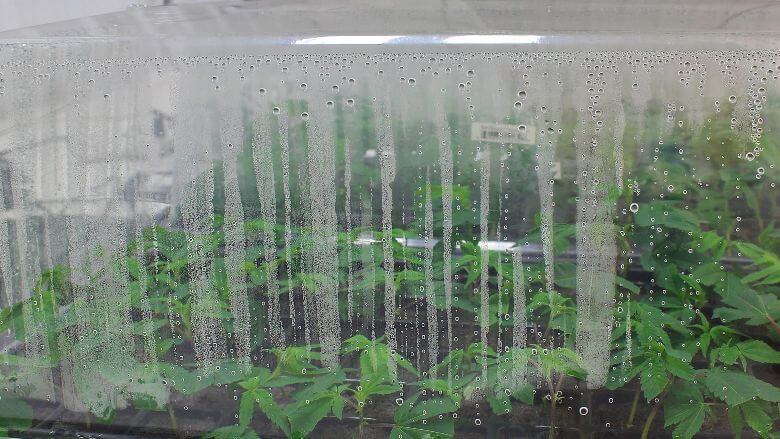
The warmer the air, the more water vapor it can hold. This makes temperature and humidity levels mutually connected. However, it’s not as easy as it sounds.
Smaller plants don’t produce much water vapor. This is usually when raising humidity is critical. You’ll need lower humidity when you have larger plants and more plants.
To give you a clearer picture, here’s what’s recommended depending on the growth stage of your cannabis plants:
Clones or Seedlings
- Recommended Temperature: 74-78 degrees Fahrenheit
- Recommended Humidity: 70% to 75%
Consider this the baby stage of your plants. This is when they develop their root systems; for this, they’ll need plenty of moisture in the air. Maintaining high relative humidity increases the success rate of their root growth.
Vegging Plants
- Recommended Temperature: 70-78 degrees Fahrenheit
- Recommended Humidity: 50% to 70%
You’ll need lower relative humidity for this stage since your plants have already grown their roots. Maintaining the recommended humidity is crucial here because their young roots still need the help of leaves for moisture absorption.
Flowering Plants
- Recommended Temperature: 88-75 degrees Fahrenheit
- Recommended Humidity: 40% to 50%
The flowering stage is when you’ll need low humidity to prevent the growth of mildews and molds. You also don’t want the plant to lose too much moisture when its nutrients are directed at flower production.
Harvesting Phase
- Recommended Temperature: 65-74 degrees Fahrenheit
- Recommended Humidity: 45% to 50%
Mature plants have roots that are capable of storing much moisture and leaves that can absorb water vapor as needed. Maintaining the recommended humidity during this stage ensures that your harvest doesn’t become brittle.Invest in a digital thermometer and a hygrometer to help you control the humidity in your grow tent.
How Can You Lower the Humidity in a Grow Tent?
High humidity in a grow tent is relatively rare because plants constantly lose water.
However, if you’re noticing slow plant growth, the presence of mildew and mold, fungal growth, and root and bud rot, these are symptoms of too much humidity in your grow room.
You can counter this and aim for low humidity in a grow room in many ways. Start with the less drastic ones. Avoid overwatering your plants, and remove any stagnant water in your grow room.
If you’re not noticing any improvement, you can increase your fan speed and turn on grow lights. You can also consider adding a dehumidifier or more fans into your grow tent for even lower humidity.
What Role Does the Grow Tent Have in Plant Growth?
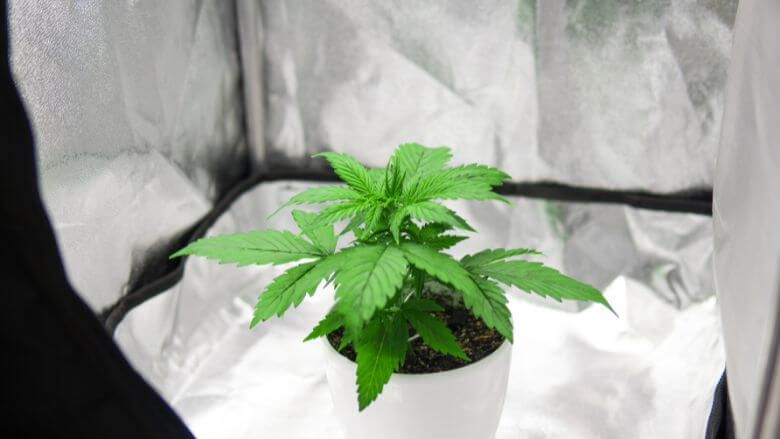
A grow tent allows you to take care of plants regardless of their growth stage. It also allows you to achieve an ideal growing environment for them even through different changes in season, weather, and climate zone.
Aside from this, it can protect your plants from naturally occurring harm like insects, mildew, mold, fungi, and parasites.
Overall, a grow tent gives you the upper hand in controlling your plant growth environment, including factors like humidity.Take note that modifying humidity levels is easier in a grow tent with a smaller air volume. These are the best small grow tents you can check out.
Frequently Asked Questions (FAQs)
Here are your humidity level questions answered to help you grow plants that are healthy for optimized yield.
What Happens if Humidity Is Too Low in a Grow Room?
You’ll notice pest infestations and unhealthy leaves when humidity is too low in an indoor grow room.
Lack of humidity dehydrates plants as there is more water transfer into the atmosphere than water intake. This lowers the immunity of plants against diseases and pests, such as insects, spider mites, molds, and mildew.
Also, low humidity levels, especially for young plants, force their roots to work harder in absorbing water since their leaves can’t. This inevitably includes excess nutrients that burn their leaves, causing them to shrivel, curl, or wilt.
Do Fans Lower Humidity in a Grow Tent?
Yes, they do. Having more fans lowers the relative humidity in a grow tent.
The ventilation that fans provide is important in maintaining the air inflow and outflow in a grow room.
Too much ventilation results in faster air circulation, but it won’t allow you to achieve higher relative humidity. In contrast, too-slow ventilation traps air, humidity, and temperature in a grow room.
This is why adjusting your ventilation can only be done temporarily to help you raise humidity.
Is 35 Humidity Too Low for a Grow Tent?
Yes, it is. 35% humidity is too low for a grow tent.
The lowest grow tent humidity level you can go for is 45% if you’re growing more mature plants. It is too low if your grow tent humidity level is at 20% to 40%. You must take action to raise humidity before you lose your growing plants.
Conclusion
Maintaining certain humidity levels is essential in keeping your growing plants healthy.
As your plants grow, the humidity level they need changes because relative humidity naturally increases.
The need for raising grow tent humidity depends on the growth stage of your plant. You don’t have to constantly increase humidity as your plants grow.


